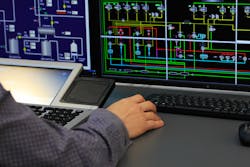IT-centric functionality comes to the HMI space
Al Letourneau is commercial portfolio manager, visualization & computing platforms at Rockwell Automation.
When will operator interfaces become IT-friendly enough that engineers are no longer required for installation and operation?
Al Letourneau, commercial portfolio manager, visualization & computing platforms, Rockwell Automation: The key to success here is not to eliminate the need for either information technology (IT) or engineers on the operational technology (OT) side, but rather to engage both groups in collaborating to deliver greater value.
Also read: Membrane puts the human in HMI
For example, deploying domain-based security across both HMI terminals and PCs running as thin clients lets IT manage authentication—who is who—and OT manage authorization—who gets to see what. That way, both groups do what they do best and contribute to the collective success of the enterprise.
On the flipside, we're bringing IT-centric functionality to the HMI space, like collaborative development in the cloud with versioning and the extensibility with C# and APIs, so HMI developers with a software-centric background will be right at home.
Also read: The changing face of operator interface
What future innovations will impact the use of operator-interface technology in manufacturing operations?
Al Letourneau, commercial portfolio manager, visualization & computing platforms, Rockwell Automation: The future is about flexibility that yields greater productivity for developers and operators, as well as greater benefits from your HMI investment.
At every point in the HMI project lifecycle, from specification to procurement, development, testing, use and support, OEMs and end users will be able to choose the specific set of options that works best in that specific application.
For example, when developing a small project you might want to use an installed application for design and deployment; for a larger one you might want to use a cloud-based environment. For the largest you might want multiple developers collaborating in the cloud with shared version control using GitHub.
Also read: HMIs create a window of opportunity
As you develop the application you could select the individual functions you need and not purchase or load the ones you don't, maximizing system performance and minimizing cost.
When deploying that application you could choose anything from a small, sealed HMI terminal, an Atom-class industrial PC, an iClass PC or even a server. You could deploy the application on an SD card, over a network or through the cloud using VPN. You could execute the application on the device itself and view it on web clients or vice versa. You could maximize uptime by distributing it to highly reliable thin clients with long mean time between failures (MTBF) and short mean time to repair (MTTR).
Best of all, you can make any of these choices independent of the others at any point in the project lifecycle, thus maximizing the benefits to the enterprise. We're truly on the brink of a transformation in the whole HMI space.
About the Author
Mike Bacidore
Editor in Chief
Mike Bacidore is chief editor of Control Design and has been an integral part of the Endeavor Business Media editorial team since 2007. Previously, he was editorial director at Hughes Communications and a portfolio manager of the human resources and labor law areas at Wolters Kluwer. Bacidore holds a BA from the University of Illinois and an MBA from Lake Forest Graduate School of Management. He is an award-winning columnist, earning multiple regional and national awards from the American Society of Business Publication Editors. He may be reached at [email protected]

Leaders relevant to this article:


